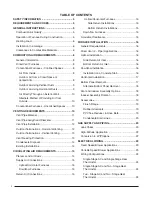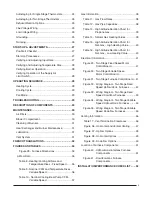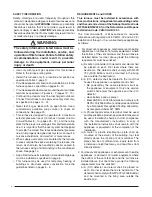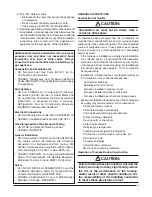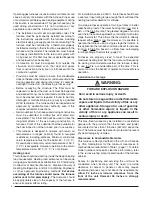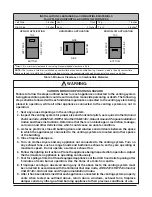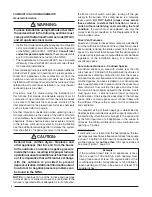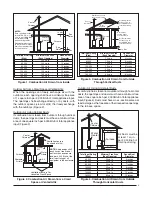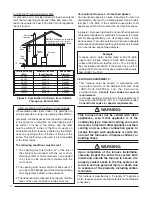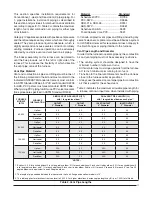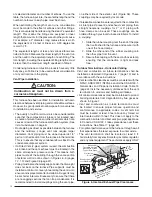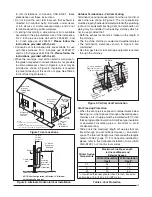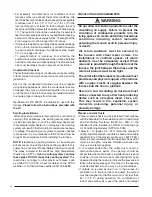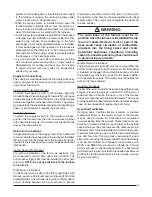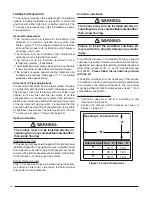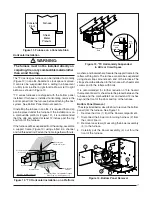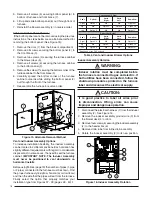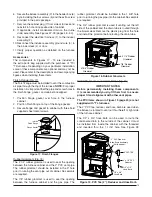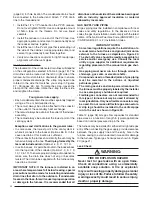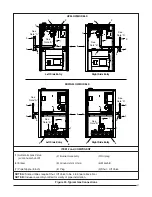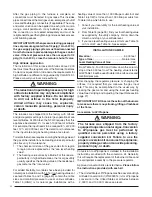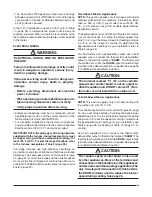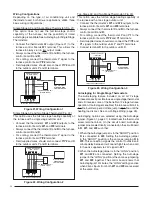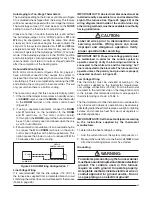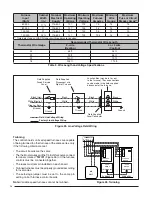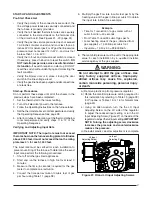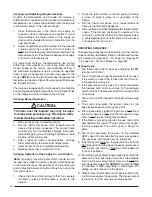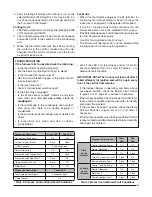
14
• For extremely cold climates or for conditions of short
furnace cycles (i.e. set back thermostat conditions) the
last 18 inches of vent pipe can be reduced. It is acceptable
to reduce from 3” to 2-1/2”, 3” to 2”, or 2” to 1-1/2” if the
total vent length is at least 15 feet in length, the vent
length is within the parameters specifi ed in Table 2 (page
11). The restriction should be counted as 3 equivalent
feet. Smaller vent pipes are less susceptible to freezing,
but must not be excessively restrictive. The length of the
2 inch pipe must not be longer than 18 inches.
• If furnace is installed horizontally, make sure the drainage
port on the in-line drain assembly is pointed downward
to ensure proper drainage of condensate. See Figure
33 - 34 on pages 44- 45.
• To prevent debris or creatures from entering the
combustion system, a protective screen may be installed
over the combustion air intake opening. The screens hole
size must be large enough to prevent air restriction.
Condensate Disposal
The method for disposing of condensate varies according
to local codes. Consult your local code or authority having
jurisdiction.
Each of the condensate drain lines must be J-trapped
using fi eld supplied parts. After the condensate lines are
J-trapped, they may be combined together into a single
run to the drain. The drain lines must be routed downward
to ensure proper drainage from furnace.
Neutralizer kit P/N 902377 is available for use with this
furnace.
Please follow the instructions provided with
the kit.
Existing Installations
When an existing furnace is removed from a vent system
serving other appliances, the existing vent system may
not be sized properly to vent the remaining appliances
(For example: water heater). An improperly sized venting
system can result in the formation of condensate, leakage,
or spillage. The existing vent system should be checked
to make sure it is in compliance with NFGC and must be
brought into compliance before installing the furnace.
NOTE:
If replacing an existing furnace, it is possible you
will encounter an existing plastic venting system that is
subject to a Consumer Product Safety Commission recall.
The pipes involved in the recall are High Temperature
Plastic Vent (HTPV).
If your venting system contains
these pipes
DO NOT reuse this venting system!
This
recall does not apply to other plastic vent pipes, such
as white PVC or CPVC. Check for details on the CPSC
website or call their toll-free number (800) 758-3688.
CIRCULATING AIR REQUIREMENTS
WARNING:
Do not allow combustion products to enter the
circulating air supply. Failure to prevent the
circulation of combustion products into the
living space can create potentially hazardous
conditions including carbon monoxide
poisoning that could result in personal injury
or death.
All return ductwork must be secured to
the furnace with sheet metal screws. For
installations in confi ned spaces, all return
ductwork must be adequately sealed. When
return air is provided through the bottom of the
furnace, the joint between the furnace and the
return air plenum must be air tight.
The surface that the furnace is mounted on must
provide sound physical support of the furnace
with no gaps, cracks or sagging between the
furnace and the fl oor or platform.
Return air and circulating air ductwork must
not be connected to any other heat producing
device such as a fi replace insert, stove, etc.
This may result in fi re, explosion, carbon
monoxide poisoning, personal injury, or
property damage.
Plenums and Air Ducts
• Plenums and air ducts must be installed in accordance
with the Standard for the Installation of Air Conditioning
and Ventilating Systems (NFPA No. 90A) or the
Standard for the Installation of Warm Air Heating and
Air Conditioning Systems (NFPA No. 90B).
• Tables 8 - 10 (pages 35 - 37) contain the maximum
airfl ow and temperature rise data for fi xed and variable
speed motors. If the maximum airfl ow is 1,600 CFM or
more, it is recommended that two openings be used for
return air on upfl ow furnaces. Downfl ow furnaces can
only use one return opening.
• It is recommended that the outlet duct contain a
removable access panel. The opening should be
accessible when the furnace is installed in service and
shall be of a size that smoke or refl ected light may be
observed inside the casing to indicate the presence of
leaks in the heat exchanger. The cover for the opening
shall be attached in such a way as to prevent leaks.
• If outside air is used as return air to the furnace for
ventilation or to improve indoor air quality, the system
must be designed so that the return air is not less than
60° F (15° C) during operation. If a combination of
indoor and outdoor air is used, the ducts and damper


